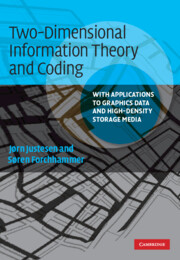 Two-Dimensional Information Theory and Coding
Two-Dimensional Information Theory and Coding Book contents
- Frontmatter
- Contents
- Preface
- 1 Introduction to information theory
- 2 Finite-state sources
- 3 Channels and linear codes
- 4 Reed–Solomon codes and their decoding
- 5 Source coding
- 6 Information in two-dimensional media
- 7 Constrained two-dimensional fields for storage
- 8 Reed–Solomon codes in applications
- Appendix A Fast arithmetic coding
- Appendix B Maximizing entropy
- Appendix C Decoding of Reed–Solomon code in F (16)
- Index
8 - Reed–Solomon codes in applications
Published online by Cambridge University Press: 05 June 2012
- Frontmatter
- Contents
- Preface
- 1 Introduction to information theory
- 2 Finite-state sources
- 3 Channels and linear codes
- 4 Reed–Solomon codes and their decoding
- 5 Source coding
- 6 Information in two-dimensional media
- 7 Constrained two-dimensional fields for storage
- 8 Reed–Solomon codes in applications
- Appendix A Fast arithmetic coding
- Appendix B Maximizing entropy
- Appendix C Decoding of Reed–Solomon code in F (16)
- Index
Summary
Introduction
In Chapter 3 we introduced linear error-correcting codes, and discussed how long codes can be obtained from short codes by the product construction. Reed–Solomon (RS) codes over larger alphabets were presented in Chapter 4, where we discussed the Datamatrix format as an example of how RS codes can be used to protect binary data. In this chapter we continue the analysis of these themes insofar as they relate to error correction in video and other applications.
We describe constructions of long error-correcting codes that are suitable for encoding of two-dimensional (2-D) media. The size of the pages makes it desirable to have relatively long codes, and 2-D constructions are often used to obtain long codes. However, there is not necessarily a link between the 2-D structure of the media and the code. In the last section we suggest that very long codes could be given a structure that would allow the 2-D structures to be connected, and that such a code could be partially decoded in cases in which only a subset of the data has to be retrieved.
Binary images of Reed–Solomon codes
The RS codes that are used in applications are always based on the fields F(2m). Here m = 8 is the traditional choice, but future applications are likely to use larger fields. As discussed in Section 4.6, the field is often constructed from a so-called primitive polynomial, p(z).
- Type
- Chapter
- Information
- Two-Dimensional Information Theory and CodingWith Applications to Graphics Data and High-Density Storage Media, pp. 146 - 157Publisher: Cambridge University PressPrint publication year: 2009


